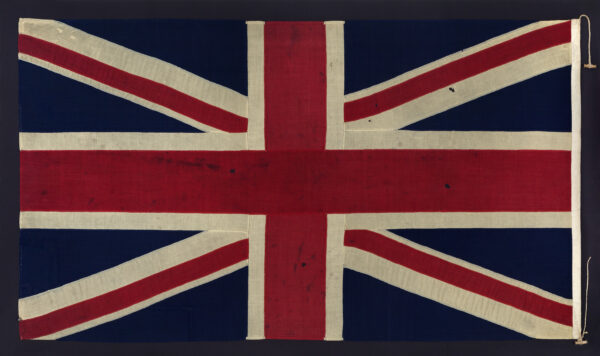The Lost Union Flag of H.M.S. Royal Sovereign at The Battle of Trafalgar
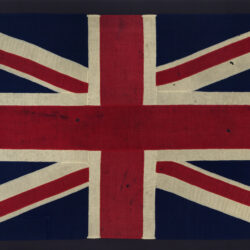
A RARE AND FINELY PRESERVED UNION FLAG FLOWN FROM THE FORESTAY OF VICE ADMIRAL LORD COLLINGWOOD’S FLAG SHIP ROYAL SOVEREIGN FLOWN BY ORDER OF ADMIRAL VISCOUNT NELSON AT THE BATTLE OF TRAFALGAR, 21ST OCTOBER, 1805
Hand-stitched wool bunting with weighted edge, battle worn with evidence of powder stains and splinter tears (later 19th century sleeve stencilled BENJm EDDINGTON / MAKER / LONDON BRIDGE S.E)
Recently conserved and stabilised. Mounted and framed.
60 x 108in. / 1525 x 2745mm.
PROVENANCE
Charles Aubrey Antram R.N. (1785 – d.s.p.1831), Master’s Mate in Royal Sovereign at the Battle of Trafalgar.
By family descent to:
His sister Rachel Nelson Lloyd, née Antram (1803-d.s.p.1884).
Her nephew: Owen John Dunn (1846-1925).
His son: Captain William Henry Dunn (1889-1986).
By his gift to: William Ames (1919-2003).
His deceased sale: A Rare Early 19th Century Naval Union Flag, Lot 61, Maritime Models, Christies, South Kensington, 26 May 2004.
Private Collection, UK.
EXHIBITED
26 June – 1 July 2025: Treasure House, Chelsea.
Price: £450,000.
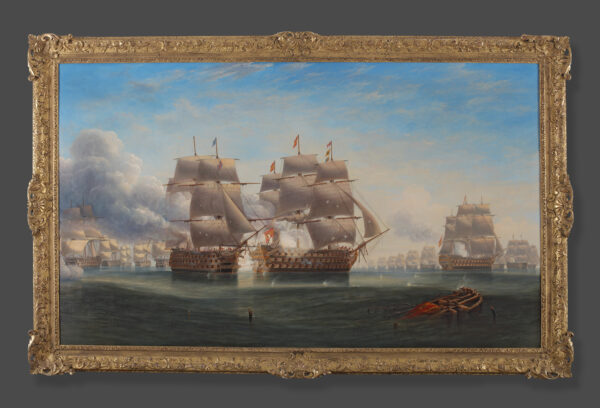
JOHN WILSON CARMICHAEL (1799-1868)
The Opening Engagement at Trafalgar; H.M.S. ‘Royal Sovereign’ raking the stern of the Spanish flagship ‘Santa Ana’
Oil on canvas, signed and dated 1856. 106 by 180.3 cm. (41¾ by 71inches)
Private Collection, UK.
Son of a purser, Charles Aubrey Antram (1788-1831) was one of three brothers who served with distinction in Nelson’s navy. His elder brother George Antram (1779-1847) was severely wounded as a midshipman in Nelson’s flagship Vanguard at the Battle of the Nile, and afterwards acted as a standard bearer at the admiral’s funeral in 1806, whilst his younger brother Simon Antram (1786-1862) was an able seaman in Nelson’s flagship St. George at the Battle of Copenhagen. A fourth brother, Joshua Antram (1797-1848), sailed in the merchant navy and was drowned in Burma. The family’s close association to Nelson is evident by the naming of three younger sisters in honour of the admiral and his wife.
The brothers who served in the Royal Navy all died childless leaving their naval relics to descend to their sister Rachel Nelson Lloyd, née Antram (1803- 1884). She, too, died childless in 1884 when the relics―including the Trafalgar Union Flag―passed to her great nephew Owen Dunn (1846-1925) with whose family she had resided in Finchley after her husband died in 1861. These relics comprised portraits of the Antram brothers, a telescope believed to have been given to Simon Antram by Nelson and a cellarette from the admiral’s cabin in which the flag was preserved. It seems likely that it was Owen Dunn who took the flag to Edgington’s in Southwark―the celebrated flag and tent makers who had exhibited at the 1851 Great Exhibition―for the fitting of a new sleeve at the hoist end to display the flag, possibly for the Trafalgar centenary celebrations in 1905. The next owner was Owen Dunn’s son Captain William Henry Dunn (1889- 1986), a veteran of the First World War. Captain Dunn knew the flag he had inherited was a souvenir from an important naval battle but he believed, wrongly, in a 1975 letter to the National Maritime Museum, Greenwich that it had been flown at the Battle of the Nile and had been kept by midshipman George Antram in Vanguard. However, that action predated the Act of Union with Ireland in 1801 following which the Union Flag was adapted to its current form incorporating the red saltire of St Patrick. Trafalgar was the only battle of Nelson’s era where Union Flags were ordered to be worn.
Before he died, Captain Dunn gave the Antram family relics to his friend William Ames (1919-2003) who had served in the Royal Navy during the Second World War. In 1999, Ames took the various relics to the BBC’s Antiques Roadshow at Highclere Castle where they were filmed but not broadcast. Following the death of William Ames, the flag was offered for sale at Christies in London without attribution or family provenance and sold to a private collector.
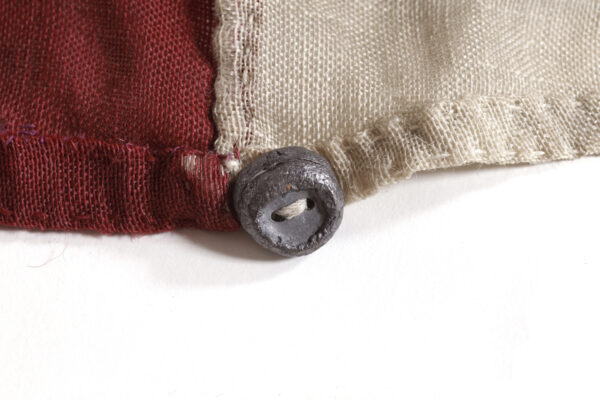
At that time, the only surviving Union Flag from the Battle of Trafalgar was thought to have been kept by Stephen Hilton, master’s mate―like Charles Antram―in the 74-gun ship-of-the-line Minotaur. Then on display at St Mary the Virgin, Selling, in Kent, Minotaur’s flag has since been purchased by the National Maritime Museum. The discovery and widely-publicised sale at auction in 2007 of the Union Flag from Spartiate led to further research into the use of Union Flags at Trafalgar, examination of Nelson’s original order, and to the re-identification of Royal Sovereign’s lost flag.
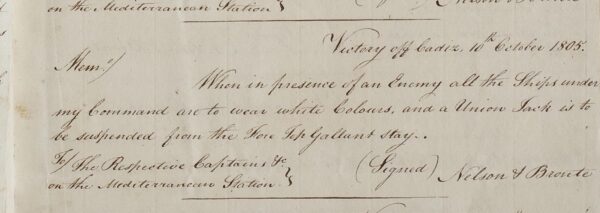
THE USE OF THE UNION FLAG IN THE SAILING NAVY.
Introduced by James I in 1606, the Union Flag was intended for general use at the mast head as a national flag at sea. A few years later, a smaller Union Flag was ordered to be worn at the jackstaff on the bowsprit to specifically identify a ship of the Royal Navy. Although this so-called Union Jack fell out of use in the later eighteenth century with the introduction of headsails causing the disappearance of the jackstaff, the name has stuck in popular usage for all Union Flags. The formal arrangement of the Royal Navy into three squadrons: red, white and blue with ensigns to match, replaced the need for the Union Flag at sea. However, the Admiral of the Fleet was still entitled to wear a Union Flag on the mainmast of his flagship whilst a vice-admiral―such as Nelson at Trafalgar―could display the flag on his foremast. An evolving system of signals also enabled the admiral to use the Union Flag to summon officers to his flagship or to call a court-martial.
The Union Flag was never designed as a battle flag. By Nelson’s day, despite the coloured squadron system, all ships were expected to wear a red ensign in action. Unusually, however, on 10 October 1805, just eleven days before the Battle of Trafalgar, Nelson instructed his captains in his standing orders that: ‛When in the presence of an enemy all the Ships under my Command are to wear white Colours, and a Union Jack is to be suspended from the fore top gallant stay’.
Famed for his meticulous preparation, Nelson issued this unorthodox order ahead of what he anticipated would be a large and confused action against the combined fleets of Spain and France. Veteran of three fleet actions―the battles of Cape St. Vincent, Nile and Copenhagen―and numerous single ship engagements; Nelson knew from bitter experience how friendly fire might compromise his already outnumbered and outgunned fleet. His special flag orders, therefore, required every ship, regardless of squadron, to fly a large white ensign from the stern for better visibility. As extra insurance, Nelson further directed each ship to hoist a Union Flag high on the forestay, well above the thickest smoke of battle. This unusual deployment is evidenced on the Union Flag from Royal Sovereign by a small lead weight on the top right of the fly end, which in normal wear would prevent it flying. In many cases, the Union Flags used in the fleet would have been assembled by seamen in the ships using material from the flag lockers. It was not uncommon for petty officers (such as Charles Antram) or lieutenants and midshipmen to take flags as mementoes after battle.
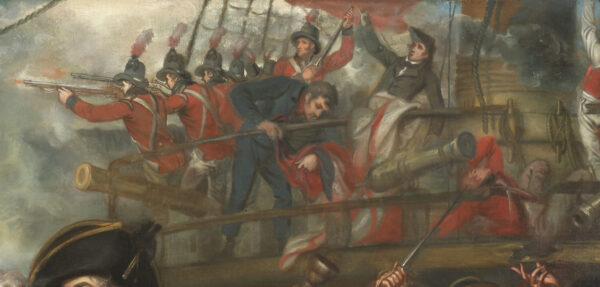
MATHER BROWN (1761-1831)
Lord Nelson’s Victory off Trafalgar (detail)
Oil on Canvas, circa 1805-7. 101.6 x 124.5cm (40 x 49 inches)
National Museum of the Royal Navy, Portsmouth.
THE MASTER’S MATE
Charles Antram was one of four master’s mates in Royal Sovereign at the Battle of Trafalgar. Their lowly sounding title belied their rating as the mates were regarded as future sea officers. A master’s mate was senior in rank to a midshipman and most were earning sea time before sitting the exam for lieutenant, as Charles Antram did in November 1810. Reporting to the master, thirty-five year old William Chalmers, the mates in Royal Sovereign had many functions including the good management of the ship’s equipment―such as rigging, ropes, sails and anchors―and assisting in navigation. Like Stephen Hilton in Minotaur, Antram’s keeping of Royal Sovereign’s Union Flag after the action suggests that he was signal mate at the Battle of Trafalgar. The other mates would command the forecastle gun and batteries on the gun decks. Working on the upper deck, the master and his mates were vulnerable to enemy fire. Twenty four masters and mates were killed or wounded at the Battle of Trafalgar, a disproportionately high casualty rate compared to the gun crews below. The fatalities in Royal Sovereign included William Chalmers who was conning the ship beside Admiral Collingwood when ‛a great shot almost divided his body: he laid his head on my shoulder, and told me he was slain, I supported him till two men carried him off. He could say nothing to me, but to bless me; but as they carried him down he wished he could but live to read the account of the action in a newspaper.’
ROYAL SOVEREIGN AT THE BATTLE OF TRAFALGAR
Royal Sovereign was the first ship into action at the Battle of Trafalgar leading the southern or leeward column of fifteen British warships. With a recently recoppered hull, the ship was faster in the light winds than Nelson’s Victory at the head of the northern or windward column of eleven ships. Flying the flag of Admiral Cuthbert Collingwood and under command of Captain Edward Rotheram, Royal Sovereign cut the enemy line well ahead of the following British ship Belleisle and engaged the larger 112-gun Spanish flagship Santa Ana to her larboard. Watching from afar, Nelson enviously exclaimed: ‘See how that noble fellow Collingwood carries his ship into action!’ Both ships suffered grievous casualties in the ensuing duel. Santa Ana lost 238 dead or wounded whilst Royal Sovereign had 141 casualties, including the ship’s master William Chalmers. Likewise damage to Royal Sovereign was severe with much of the rigging shot away and the loss of mizzen and main masts. Only three British ships suffered more in the battle (Victory, Colossus and Bellerophon). However, Royal Sovereign’s Union Flag was still aloft when Santa Ana struck at about 2.20pm despite the foremast having been hit in several places and left tottering. Nevertheless, the ship was almost unmanageable and, unable to make signals, Collingwood―who had assumed overall command of the fleet when Nelson’s death was confirmed―was compelled to transfer to the frigate Euryalus, which also took Royal Sovereign under tow. After repair at Gibraltar, Royal Sovereign returned to Portsmouth on 18 December 1805 where the ship was paid off.
The Union Flag is depicted in ‛The Opening Engagement at Trafalgar; H.M.S. Royal Sovereign Raking the Stern of the Spanish Flagship Santa Ana’ by the marine painter John Wilson Carmichael (1799-1868). Carmichael was admired for his meticulous research and the accuracy of his maritime subjects and was one of very few contemporary artists to include the union flags in his depiction of the battle.KNOWN SURVIVING UNION FLAGS FROM THE BATTLE OF TRAFALGAR.
Worn by Royal Sovereign, which led the British attack at the Battle of Trafalgar, the flag is the most historically significant of three known surviving Union Flags from the action, and the only complete example from a 100-gun first-rate flagship.
The other flags are:
The Union Flag from Spartiate, a 74-gun third-rate warship, was sold at auction in 2009 by Charles Miller Ltd. for £396,400. Measuring 88 x 140in. (2235 x 3555mm), it had been preserved by descendants of James Clephan (1768-1851), a lieutenant in Spartiate. It is now in the collection of the Zaricor Flag Collection, Santa Cruz, USA. to be offered for sale at Christies, London on 1 July 2025 at an estimate of £500,000-700,000.
The Union Flag from Minotaur, a 74-gun third-rate warship, was purchased by private treaty in 2015 by The National Maritime Museum, Greenwich for £175,000. Measuring 89 x 122in. (2265 x 3110mm), it had been preserved by Stephen Hilton (1787-1872), a master’s mate in Minotaur. It is now on display in the Nelson & Navy Gallery, National Maritime Museum, Greenwich.
In addition, fragments survive of the Union Flag from Victory which was famously shredded by distraught seamen at the close of Nelson’s State Funeral at St. Paul’s Cathedral on 9 January 1806. A large torn fragment of Victory’s flag fetched £297,000 at Sotheby’s on 17 January 2018.
With thanks to Charles Miller for his help in researching and cataloguing the
Battle of Trafalgar Forestay Flag from H.M.S. Royal Sovereign.
